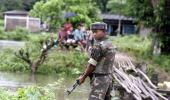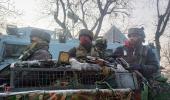It is on the exact spot where the Guru is said to have created 108 waterfalls, that the Yangtse clash took place between the Indian Army and the Chinese PLA on the night of December 9, 2022.
As it had done in Ladakh in May 2020, the PLA tried to change the unmarked LAC in the Yangtse sector in Arunachal Pradesh.
It was the most serious border incident since the Galwan Valley clash in June 2020, notes Claude Arpi.
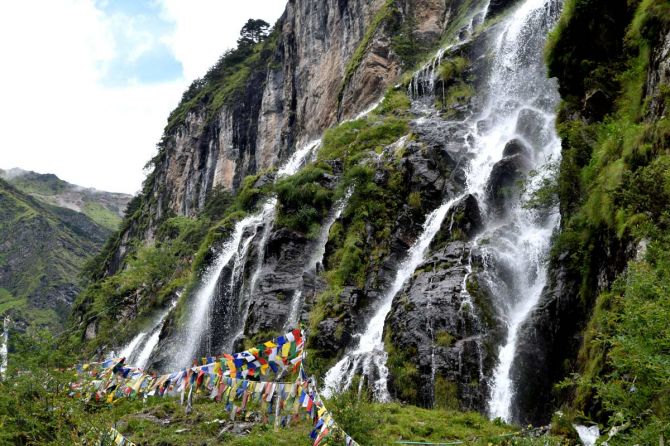
The Chumig Gyatse Holy Waterfalls are truly special and worth a visit, if you have the occasion (or the good karma) and this for several reasons.
First, this very sacred place in Arunachal Pradesh has been blessed by Guru Padmasambhava (also known as Guru Rinpoche by the Tibetans), the great yogi and tantric master who lived in the 8th century AD.
Padmasambhava ('Born from a Lotus') was a tantric Vajra practitioner from Oddiyana (or Swat, in today's Pakistan) who played a crucial role in the establishment of Buddhism in Tibet.
After King Trisong Detsen invited Shantarakshita, the Nalanda Abbot to Tibet to teach Buddhism, the latter faced a lot of difficulties from the old shamanic faith. The king had to send him back to Nepal to fetch Padmasambhava in order to tame the local spirits and covert the Tibetans with his magical and ritual powers.
Padmasambhava practiced various forms of tantric Buddhist yoga and thanks to his great occult siddhis, the Samye monastery, the first Buddhist monastery in Tibet, could be constructed.
The Great Guru extensively visited the border areas and his legacy can still be found not only in Nepal and Bhutan (for example, the Taktsang monastery in Paro), but on the Indian side too (Rewalsar in Himachal Pradesh or Gurudongmar in Sikkim, etc).

The 2022 Yangtse Clash
It is on the exact spot where the Guru is said to have created 108 waterfalls, that the Yangtse clash took place between the Indian Army and the Chinese People's Liberation Army on the night of December 9, 2022.
As it had done in Ladakh in May 2020, the PLA tried to change the unmarked Line of Actual Control in the Yangtse sector, northeast of Tawang in Arunachal Pradesh.
According to the Indian media, violent clashes took place between the two armies which confronted each other with nail-studded clubs and other melee weapons on a ridgeline above the waterfalls.
It was the most serious border incident along the boundary since the Galwan Valley clash in June 2020.
After receiving timely reinforcements, the Indian troops were able to send back the Chinese PLA to their side of the LAC, though six Indian soldiers who with severe injuries had to be flown to Guwahati for medical treatment. As usual, the casualties on the Chinese side were not disclosed.
Interestingly, Yangtse was one of three main 'disputed' areas in 1960 when the Indian and Chinese officials held several months of talks to try to sort out the boundary issue (the other places were Khenzimane/Sumdorong Chu sector in the west and Longju sector in today's Upper Subansiri district).
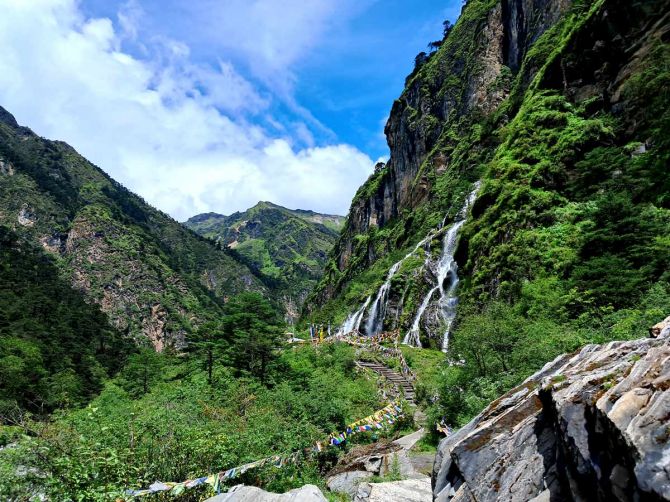
A Tourist Spot
The good news is that the area has recently been opened to Indian tourists.
To reach the place is a pilgrimage in itself; it takes some 4 hours drive from Tawang. One first moves in the direction of Bumla, the pass where senior Indian and Chinese officers regularly meet to sort out their differences of 'perceptions', it is known as Border Meeting Point or BPM.

Just 6 km before Bumla, one takes an eastward turn towards Nagu-la Lake: 'One of the most picturesque places to visit in Tawang. ...with some alluring reflections of the mountain waters in its serene waters, Nagula Lake is a captivating tourist attraction in Tawang,' says a tourist site.
The scenery around the lake and the pass (at an altitude of 4,200 meters) leaves you spellbound. Of course, one encounters a heavy military presence, due to the proximity of the border and the constant Chinese belligerence.

Then after one more hour drive on the high plateau one reaches a grazing ground for a large number of healthy yaks and often wild horses; the only vegetation is rhododendrons.

Later, moving down, one returns to a thickly forested area with extremely old and tall pine trees. The sight of the sharp gorges further down is rather scary. It takes one more hour of driving in this stunning paradise-like landscape before reaching the Tsona chu (river) gushing down from Tibet a few kilometers upstream.
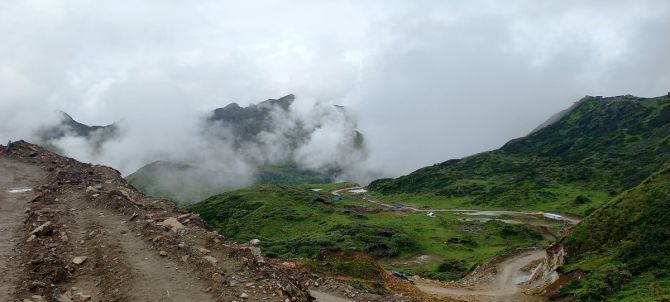
Everywhere on the road, one crosses groups of local ladies working for the Border Road Organisation (BRO) to improve the road. In this very difficult terrain, the BRO's work is really commendable.
After a few hundred metres walk, the great falls dropping from the cliffs like fairy hair suddenly appear; a signboard says 'Enjoy the Magical, Mystical & Magnificent falls.'
Though the fighting took place on the ridge above the falls, it is in this idyllic surrounding that the clash took place in December 2022.

Chumig Gyatse
It is truly is a magical place; as in most of the places associated with Guru Padmasambhava, one can feel the presence of the great master around.
A small Chumig Gyatse monastery, below the falls, was inaugurated by the young chief minister of Arunachal Pradesh, Pema Khandu on July 20, 2020 (note that it was a month after the Galwan incident in Ladakh). Khandu had then to walk for an hour or so before reaching the holy place.
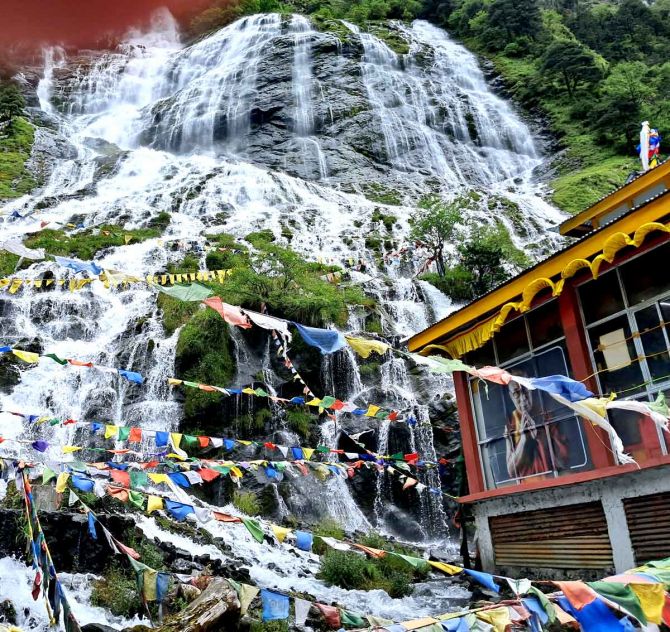
Below the falls, a board said: 'The temple is a symbol of spirituality. The magnificent falls adds to the beauty of the temple and makes it one of the most picturesque and mystic sights on earth.'
The same board describes various beliefs about the origin of Holy Waterfalls (also known as HWF by the Indian Army). According to the most popular religious belief: ''During 8th century an epidemic struck the villages of this area and all villagers came to Guru Padmasambhava in the hope for relief.
'Guru Padmasambhava mediated and did penance in the area; in order to make the villagers free from the epidemic, [he] took out his rosary beads garland & threw the 108 beads on the mountain.
'Wherever the beads fell, a stream of water originated and thus Holy waterfalls came into existence. It is believed that the water here has magical medicinal values."

It is said that Guru Rinpoche spent five days near the falls before moving to another retreat.
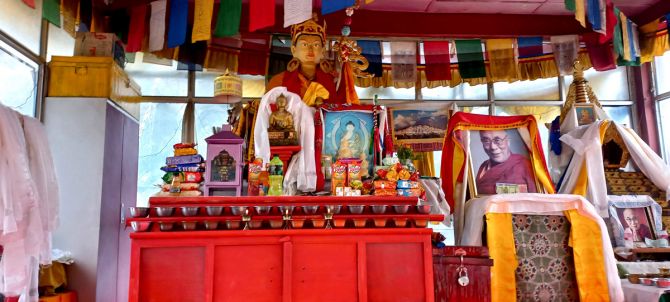
The board near the small gompa which houses a statue of Guru Rinpoche (and where a resident Lama reads the scriptures) informs us: 'The Holy water is believed to have medicinal and healing properties and anyone consuming it with faith & devotion gets healed from all his ailments.
'Also childless couples if consumes holy water with credence, then blessings of Guru Padmasambhava are showered upon them and they are blessed with children. ...Chumig Gyatse is a sight to behold.'
Chumig Gyatse and the LAC
The Chumig Gyatse falls lie some 250 metres from the LAC; it is today the main landmark in the Yangtse sector where the two prominent ridges, namely the Bumla ridge to its southwest and the Tulung-la ridgeline to its northeast, meet.
The McMahon Line at Yangtse is said to be coterminous with the two ridgelines.
It is only after the Chinese tried to occupy the Wangdung pasture in the Sumdorung Chu area in 1986 that Indian troops moved troops to the ridge above the falls and occupied the area.
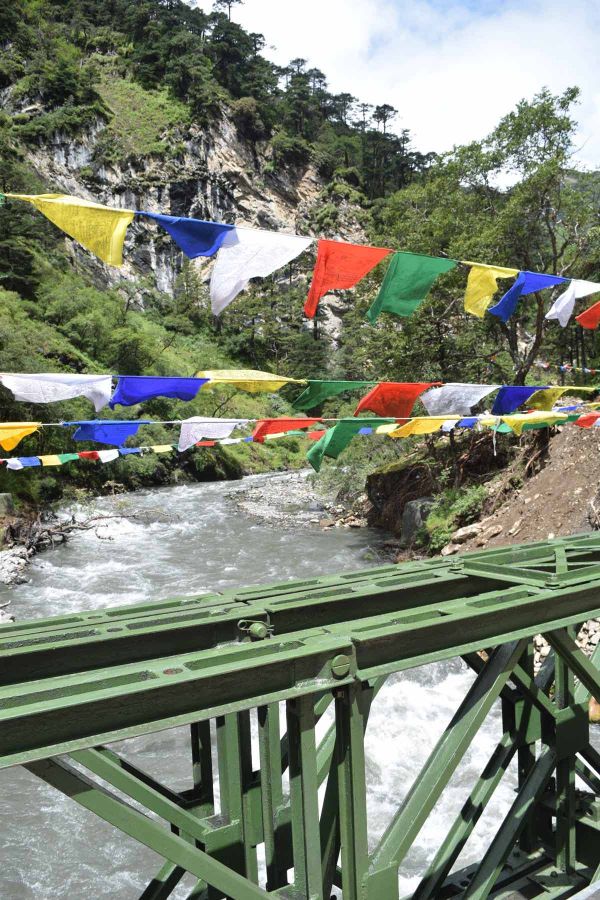
Open for Tourism
It is a great move from the government of Arunachal Pradesh and the ministry of defence to have decided to allow tourists to visit the sacred place.
Isn't it the best proof that the area belongs to India despite the repeated Chinese claims?
Last year only, 6,000 Indian pilgrims/visitors had the darshan of the falls. Probably a similar number will visit this year.
A Tibetan friend told me that by throwing his mala, Guru Rinpoche certainly knew that one day the area would be disputed; he marked the place with the beads of his mala.
A news item reported by Radio Free Asia came back to mind: A three-storyed high statue of Guru Padmasambhava was destroyed at the Chanang Monastery in Drago county of the Kardze Tibetan Autonomous Prefecture in Tibet.
According to sources living in exile and satellite imagery, it was razed in late January 2022.
Satellite imagery of the Chanang Monastery taken October 3, 2019, shows the statue of the Guru on the site, but on another shot taken February 25, 2022, one can see the destruction of the statue indicated by the circular mounts on the ground.
'Though there has been no explanation of the reasons for its destruction, it falls in line with the Chinese government's policy of demolishing Tibetan religious sites in the region,' a Tibetan told Radio Free Asia.
It is really a grace that the falls are on the Indian side of the LAC; had they been 500 meters north, Guru Padmasambhava would never have been even mentioned, let alone worshipped.
Further, many believe that the Tantric Master still offers protection to the Indian soldiers who guard this remote scenic spot.
Claude Arpi is Distinguished Fellow, Centre of Excellence for Himalayan Studies, Shiv Nadar Institution of Eminence (Delhi).
Photographs curated by Manisha Kotian/Rediff.com
Feature Presentation: Ashish Narsale/Rediff.com

